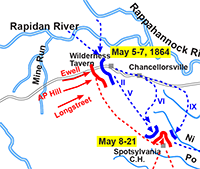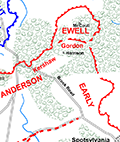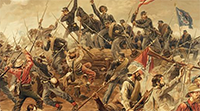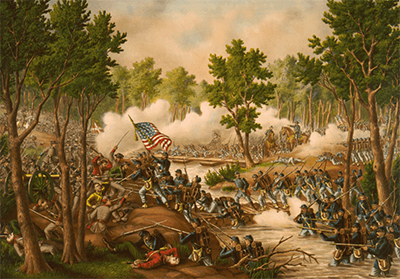The Battle of Spotsylvania Court House
The Battle of Spotsylvania Court House was an inconclusive clash between Union and Confederate troops during the American Civil War. It was the second battle in the Overland Campaign, which eventually led to the surrender of Confederate troops in April 1865. 
The day after the last day of fighting at the Wilderness, Union top commander Ulysses S. Grant ordered his troops to head south, toward Richmond. Specifically, the order was to capture Spotsylvania Court House, a crossroads that controlled the northern approach to Richmond, the capital of the Confederacy. Grant's counterpart, Army of Northern Virginia Gen. Robert E. Lee, anticipated the strategy and ordered his own troop engagement to the very same place. Spotsylvania Court House was only 10 miles to the southeast of the Wilderness. The race was on. Union troops under Maj. Gen. Gouverner Warren set out at a marginally quick pace. Going even more quickly were Confederate infantry under Maj. Gen. Richard Anderson and Confederate cavalry under Maj. Gen. J.E.B. Stuart. Using local knowledge and avoiding the delays that continually plagued the movements of the sometimes cumbersome Army of the Potomac, the Confederate troops got there first. When the Union troops arrived, on May 9, they found Confederate troops dug in behind several miles of trenches. In addition, the defenders killed Maj. Gen. John Sedgwick while he was scouting the perimeter. 
The defenders had arrayed their defenses in a V-shape, with the tip protruding outward. The area inside that V-shape was known as the Mule Shoe. The first attack occurred late in the day on May 10. Another followed. Neither dislodged any of the defenses. A brief yet spectacular success late in the day was a brief breach into the Mule Shoe led by Col. Emory Upton. Unsupported, the Union troops withdrew. 
The tactics employed by Upton's men were new: Rather than having his men advance in long lines, stopping to fire and reload at will, Upton formed his troops into groups of 12, 3-by-4, and ordered them to rushed the enemy position, trading firing time for attacking time, with the goal to reach the enemy line and attack with bayonets. Grant was so impressed with Upton, his men, and their success that he promoted Upton to brigadier general and gave orders for others of his troops to employ the same strategy during the next attack. The Union troops spent most of the following day shifting positions, readying for a major assault. Lee, convinced that Grant was going to try to slip by the Confederate emplacements and make a break for Richmond, pulled artillery from within the Mule Shoe and deployed it elsewhere. 
A predawn Union attack on May 12 breached the Mule Shoe again, this time for good, Lee's order to return the Mule Shoe-defending artillery coming too late. Fighting was particularly intense in one area that came to be known as the Bloody Angle, in which the two armies fought hand-to-hand for nearly 20 hours. Exacerbating the conditions was a driving rainstorm. After dark, Lee ordered his troops to abandon the Mule Shoe altogether and form up ranks further back. No further Union attack came on the next day or the next or the next. On the sixth day following, Union troops attacked again but gained no ground. Grant had seen enough. On May 20, he gave the order that Lee had been expecting all along, to move east and then head south. All told, Union casualties numbered 18,399 (2,725 dead, 13,416 injured, 2,258 captured or missing); Confederate casualties numbered 12,421 (1,467 dead, 4,783 injured, and 6,171 captured or missing). |
|
Social Studies for Kids
copyright 2002–2025
David White




